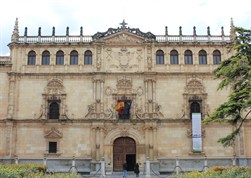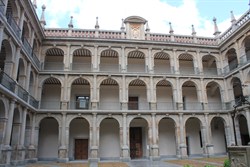The Jesuits at the Complutense University of Alcalá
 The efforts made by Cardinal Cisneros, from 1508, to found a new university, called the Complutense University, in Alcalá de Henares, changed the face of a small town which was, until then, little known. The curriculum developed for the new University by Cisneros converted it into a place of advanced learning for its time, with a new mentality, well before the Lutheran Reformation or the influence of humanism of Erasmus. In this sense the polyglot Bible (simultaneously translated into Hebrew, Latin and greek) of 1517 is to be emphasized, as a clear signal of the enlargement of intellectual interests and the break with medieval tradition. This new concept of university attracted many Jesuits who, like their founder Ignatius of Loyola, came to Alcalá driven by the spirit of humanism. The Jesuits could study at the university created by Cisneros, yet they were not permitted, in any way until the end of the sixteenth century, to teach there. After lengthy discussions within the university, which saw itself deprived of many students because many of them attended lectures given by members of the Company in small colleges, the Company was granted what was known as general y hora to be able teach theology, namely the availability of a classroom at the university during a few well-defined hours during which only some Jesuits, not all, could give lessons. The decision reflected the growing importance that the Society was acquiring in the city and in the university. It was in the seventeenth century that this privilege was extended to the whole Order and not limited to the most famous Jesuit theologians.
The efforts made by Cardinal Cisneros, from 1508, to found a new university, called the Complutense University, in Alcalá de Henares, changed the face of a small town which was, until then, little known. The curriculum developed for the new University by Cisneros converted it into a place of advanced learning for its time, with a new mentality, well before the Lutheran Reformation or the influence of humanism of Erasmus. In this sense the polyglot Bible (simultaneously translated into Hebrew, Latin and greek) of 1517 is to be emphasized, as a clear signal of the enlargement of intellectual interests and the break with medieval tradition. This new concept of university attracted many Jesuits who, like their founder Ignatius of Loyola, came to Alcalá driven by the spirit of humanism. The Jesuits could study at the university created by Cisneros, yet they were not permitted, in any way until the end of the sixteenth century, to teach there. After lengthy discussions within the university, which saw itself deprived of many students because many of them attended lectures given by members of the Company in small colleges, the Company was granted what was known as general y hora to be able teach theology, namely the availability of a classroom at the university during a few well-defined hours during which only some Jesuits, not all, could give lessons. The decision reflected the growing importance that the Society was acquiring in the city and in the university. It was in the seventeenth century that this privilege was extended to the whole Order and not limited to the most famous Jesuit theologians.
 The main seat of the University was the Colegio Mayor de San Ildefonso (College of Saint Ildephonsus), which was converted into the head of a system of other small, complementary colleges scattered throughout Alcalá. In the Colegio Mayor de San Ildefonso there are elements of the sixteenth and seventeenth centuries, the Renaissance and Baroque periods. The impressive façade (photo 1), completed in 1553, is Plateresque. The whole façade is divided into three parts, which depicts the hard road to knowledge. At the bottom are the four Fathers of the Church in the medallions, symbolizing the basis of wisdom; on the second floor, on which the balcony of the library was placed, titans and warriors represent the effort that learning requires; at the top, there is the coat of arms of the Emperor Charles V, symbolizing earthly power, surrounded by the figures of Perseus and Athena, who, in classical mythology triumph over ignorance and provide the light of knowledge. The part above the imperial arms is dominated by the figure of God who blesses and serves as a culmination to the entire learning process. Inside stands the Patio Mayor de Escuelas (photo 2), the construction of which began in 1617 and ended in 1662 according to the designs of the architect Juan Gómez de Mora. Made in Herrera’s style, in gray granite, patio spreads over three floors of arches topped by a balustrade decorated with pyramids and spheres. In the centre of the cloister there is an ancient well with the arms containing a swan (cisne), which allude to the name of Cisneros, the founder of the University.
The main seat of the University was the Colegio Mayor de San Ildefonso (College of Saint Ildephonsus), which was converted into the head of a system of other small, complementary colleges scattered throughout Alcalá. In the Colegio Mayor de San Ildefonso there are elements of the sixteenth and seventeenth centuries, the Renaissance and Baroque periods. The impressive façade (photo 1), completed in 1553, is Plateresque. The whole façade is divided into three parts, which depicts the hard road to knowledge. At the bottom are the four Fathers of the Church in the medallions, symbolizing the basis of wisdom; on the second floor, on which the balcony of the library was placed, titans and warriors represent the effort that learning requires; at the top, there is the coat of arms of the Emperor Charles V, symbolizing earthly power, surrounded by the figures of Perseus and Athena, who, in classical mythology triumph over ignorance and provide the light of knowledge. The part above the imperial arms is dominated by the figure of God who blesses and serves as a culmination to the entire learning process. Inside stands the Patio Mayor de Escuelas (photo 2), the construction of which began in 1617 and ended in 1662 according to the designs of the architect Juan Gómez de Mora. Made in Herrera’s style, in gray granite, patio spreads over three floors of arches topped by a balustrade decorated with pyramids and spheres. In the centre of the cloister there is an ancient well with the arms containing a swan (cisne), which allude to the name of Cisneros, the founder of the University.
